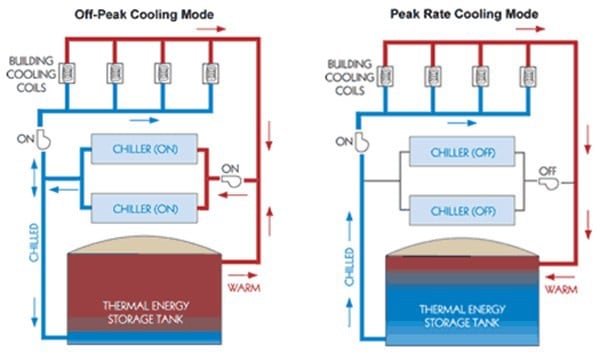The global energy mix is on a gradual but sure transformation that is being spurred by technology advance largely. Renewables are growing at an amazing rate, with estimates indicating that this form of energy could support 14% of global energy needs by 2040. As energy efficiency increase, the share of oil in the energy mix will probably decline gradually. However, its demand will still be high in the coming years. The shifts that we are witnessing may affect different areas of the economy differently, but they all mean one thing- negative effect on the base-load energy generation. Getting the right performance condition through intelligent thermal energy storage methods can enhance energy efficiency, improve quality of life and support machinery life. With TES a critical component of operations in many facilities, improvements represent a sizeable cost.
Intelligent Thermal Energy Storage Methods

Fig 1: TES System in Off-Peak and Peak Modes
TES is not a new technology, but it has been the subject of intensive research in the last decade. These efforts have led to advances and innovations in these areas:- TES types
- Materials
- Measurement techniques
- Control strategies
While there has been good progress in these areas, optimizing energy storage systems remains one of the biggest problems for many facilities, especially in the commercial and industrial sector. Storage appliances should communicate with consumption and generation for sufficient synchronization of energy availability. Because the auto-analytics is already arriving, we cannot afford to overlook data analysis. Good news- Intelligent thermal energy storage methods are available for enhanced efficiency in facilities and optimized energy grids.
TES Technologies Gaining Popularity
The aim of intelligent thermal energy storage methods is to enhance the management of systems for optimal thermal energy. Here are two methods that may add the much needed reliability and efficiency to TES systems.
TES Optimization Software
TES technology enhances profitability in combined cycle power plants through pricing patterns that vary depending on whether it is off-peak or on-peak period. They chill water during off-peak, then cool turbine inlet air during peak demand for improved heat rate and boosted MW output. The problem with TES systems is that they follow default schedules, which only depend on vendor design parameters. These parameters disregard important factors such as weather conditions, plant thermodynamic state and actual electricity prices. The uncontrolled thermocline level that characterizes default schedules can affect heat rate and megawatt numbers. Optimizing a cooling plant with these factors in mind can add significant value. Intelligent optimization software is available for exactly that purpose. This software is so efficient that it determines an optimal schedule based on real market situations. It gathers data from the power plant for computation purposes. Some of the benefits of this software include:
- A variety of operating scenarios
- Guides operator on tank filling, division between chiller and tank, and best T2 set point
- TES system automation based on day-ahead schedule
- Additional annual profitability of up to $1,000,000
Smart City Solutions
In 1950, only 30% of the global population lived in cities while in 2050, that figure will have risen to 66%. Because of the dangers posed by global warming, the effects of this kind of shift in human settlement must be curtailed through energy efficiency. Smart cities are some of the solutions envisioned. TES as used for district cooling purposes can promote de-carbonization efforts in these cities. TES has been used successfully in urban settings for air conditioning purposes. Now, it may be time for this technology to support air conditioning in smart cities. A smart city is an efficient and sustainable building that offers a high standard of life to the residents. Intelligent thermal energy storage solutions for peak hour coverage can be applied in such cities. Reason for this is that the Internet of Things is already with us. The integration of intelligent TES with smart cities will offer users electricity that is more efficient. Because of the technological barriers that come with smart city setup, infrastructure upgrades are inevitable if this solution is to succeed. Upgrades are necessary to counteract the peak load that occurs during summer months or any other time when demand is high.
Conclusion
As the cooling energy demand rises, we need thermal energy storage methods that are feasible and more accurate. That is why it is pleasing to note that intelligent TES methods are slowly gaining ground as the market seeks for the best way to cover peak hours. These methods offer several benefits as compared to conventional cooling. Minimized energy consumption, improved safety, enhanced efficiencies and better bottom line should be attractive enough for more investors to start using these modern approaches. For more information about smart TES methods, please contact ARANER.










